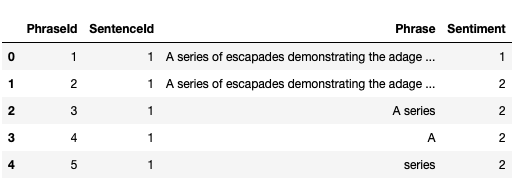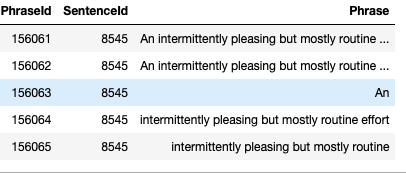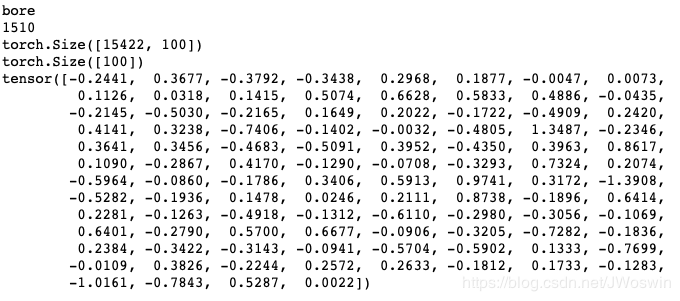主要内容:
- 定义Field:声明如何处理数据
- 定义Dataset:得到数据集,此时数据集里每一个样本是一个 经过 Field声明的预处理 预处理后的 wordlist
- 建立vocab:在这一步建立词汇表,词向量(word embeddings)
- 构造迭代器:构造迭代器,用来分批次训练模型
1. 下载数据:
kaggle:Movie Review Sentiment Analysis (Kernels Only)
train.tsv contains the phrases and their associated sentiment labels. We have additionally provided a SentenceId so that you can track which phrases belong to a single sentence.
test.tsv contains just phrases. You must assign a sentiment label to each phrase.
The sentiment labels are:
0 - negative
1 - somewhat negative
2 - neutral
3 - somewhat positive
4 - positive
下载得到:train.tsv和test.tsv1.1 读取文件,查看文件
import pandas as pddata = pd.read_csv('train.tsv', sep='\t')test = pd.read_csv('test.tsv', sep='\t')
1.2 data.tsv
data[:5]

1.3 test.tsv
test[:5]

1.4 划分验证集
from sklearn.model_selection import train_test_split# create train and validation settrain, val = train_test_split(data, test_size=0.2)train.to_csv("train.csv", index=False)val.to_csv("val.csv", index=False)
3. 定义Field
首先导入需要的包和定义pytorch张量使用的DEVICE
Torchtext采用了一种声明式的方法来加载数据:你来告诉Torchtext你希望的数据是什么样子的,剩下的由torchtext来处理。import spacyimport torchfrom torchtext import data, datasetsfrom torchtext.vocab import Vectorsfrom torch.nn import initDEVICE = torch.device("cuda" if torch.cuda.is_available() else "cpu")
实现这种声明的是Field,Field确定了一种你想要怎么去处理数据。
data.Field(…)
Field的参数如下:
- sequential: Whether the datatype represents sequential data. If False, no tokenization is applied. Default: True.
- use_vocab: Whether to use a Vocab object. If False, the data in this field should already be numerical. Default: True.
- init_token: A token that will be prepended to every example using this field, or None for no initial token. Default: None.
- eos_token: A token that will be appended to every example using this field, or None for no end-of-sentence token. Default: None.
- fix_length: A fixed length that all examples using this field will be padded to, or None for flexible sequence lengths. Default: None.
- dtype: The torch.dtype class that represents a batch of examples of this kind of data. Default: torch.long.
- preprocessing: The Pipeline that will be applied to examples using this field after tokenizing but before numericalizing. Many Datasets replace this attribute with a custom preprocessor. Default: None.
- postprocessing: A Pipeline that will be applied to examples using this field after numericalizing but before the numbers are turned into a Tensor. The pipeline function takes the batch as a list, and the field’s Vocab. Default: None.
- lower: Whether to lowercase the text in this field. Default: False.
- tokenize: The function used to tokenize strings using this field into sequential examples. If “spacy”, the SpaCy tokenizer is used. If a non-serializable function is passed as an argument, the field will not be able to be serialized. Default: string.split.
- tokenizer_language: The language of the tokenizer to be constructed. Various languages currently supported only in SpaCy.
- include_lengths: Whether to return a tuple of a padded minibatch and a list containing the lengths of each examples, or just a padded minibatch. Default: False.
- batch_first: Whether to produce tensors with the batch dimension first. Default: False.
- pad_token: The string token used as padding. Default: “”.
- unk_token: The string token used to represent OOV words. Default: “”.
- pad_first: Do the padding of the sequence at the beginning. Default: False.
- truncate_first: Do the truncating of the sequence at the beginning. Default: False
- stop_words: Tokens to discard during the preprocessing step. Default: None
- is_target: Whether this field is a target variable. Affects iteration over batches. Default: False
例:
spacy_en = spacy.load('en')def tokenizer(text): # create a tokenizer function"""定义分词操作"""return [tok.text for tok in spacy_en.tokenizer(text)]"""field在默认的情况下都期望一个输入是一组单词的序列,并且将单词映射成整数。这个映射被称为vocab。如果一个field已经被数字化了并且不需要被序列化,可以将参数设置为use_vocab=False以及sequential=False。"""LABEL = data.Field(sequential=False, use_vocab=False)TEXT = data.Field(sequential=True, tokenize=tokenizer, lower=True)
4. 定义Dataset
The fields知道当给定原始数据的时候要做什么。现在,我们需要告诉fields它需要处理什么样的数据。这个功能利用Datasets来实现。
Torchtext有大量内置的Datasets去处理各种数据格式。
TabularDataset官网介绍: Defines a Dataset of columns stored in CSV, TSV, or JSON format.
对于csv/tsv类型的文件,TabularDataset很容易进行处理,故我们选它来生成Dataset
"""我们不需要 'PhraseId' 和 'SentenceId'这两列, 所以我们给他们的field传递 None如果你的数据有列名,如我们这里的'Phrase','Sentiment',...设置skip_header=True,不然它会把列名也当一个数据处理"""train,val = data.TabularDataset.splits(path='.', train='train.csv',validation='val.csv', format='csv',skip_header=True,fields=[('PhraseId',None),('SentenceId',None),('Phrase', TEXT), ('Sentiment', LABEL)])test = data.TabularDataset('test.tsv', format='tsv',skip_header=True,fields=[('PhraseId',None),('SentenceId',None),('Phrase', TEXT)])
注意:传入的(name, field)必须与列的顺序相同。
查看生成的dataset:
print(train[5])print(train[5].__dict__.keys())print(train[5].Phrase,train[0].Sentiment)
5. 建立vocab
我们可以看到第6行的输入,它是一个Example对象。Example对象绑定了一行中的所有属性,可以看到,句子已经被分词了,但是没有转化为数字。
这是因为我们还没有建立vocab,我们将在下一步建立vocab。
Torchtext可以将词转化为数字,但是它需要被告知需要被处理的全部范围的词。我们可以用下面这行代码:
TEXT.build_vocab(train, vectors='glove.6B.100d')#, max_size=30000)# 当 corpus 中有的 token 在 vectors 中不存在时 的初始化方式.TEXT.vocab.vectors.unk_init = init.xavier_uniform
这行代码使得 Torchtext遍历训练集中的绑定TEXT field的数据,将单词注册到vocabulary,并自动构建embedding矩阵。
’glove.6B.100d’ 为torchtext支持的词向量名字,第一次使用是会自动下载并保存在当前目录的 .vector_cache里面。
torchtext支持的词向量
- charngram.100d
- fasttext.en.300d
- fasttext.simple.300d
- glove.42B.300d
- glove.840B.300d
- glove.twitter.27B.25d
- glove.twitter.27B.50d
- glove.twitter.27B.100d
- glove.twitter.27B.200d
- glove.6B.50d
- glove.6B.100d
- glove.6B.200d
- glove.6B.300d
例:
如果打算使用fasttext.en.300d词向量,只需把上面的代码里的vector=’…’里面的词向量名字换一下即可,具体如下:
TEXT.build_vocab(train, vectors='fasttext.en.300d')
到这一步,我们已经可以把词转为数字,数字转为词,词转为词向量了
print(TEXT.vocab.itos[1510])print(TEXT.vocab.stoi['bore'])# 词向量矩阵: TEXT.vocab.vectorsprint(TEXT.vocab.vectors.shape)word_vec = TEXT.vocab.vectors[TEXT.vocab.stoi['bore']]print(word_vec.shape)print(word_vec)
6. 构造迭代器
我们日常使用pytorch训练网络时,每次训练都是输入一个batch,那么,我们怎么把前面得到的dataset转为迭代器,然后遍历迭代器获取batch输入呢?下面将介绍torchtext时怎么实现这一功能的。
和Dataset一样,torchtext有大量内置的迭代器,我们这里选择的是BucketIterator,官网对它的介绍如下:
- Defines an iterator that batches examples of similar lengths together.
Minimizes amount of padding needed while producing freshly shuffled batches for each new epoch.
train_iter = data.BucketIterator(train, batch_size=128, sort_key=lambda x: len(x.Phrase),shuffle=True,device=DEVICE)val_iter = data.BucketIterator(val, batch_size=128, sort_key=lambda x: len(x.Phrase),shuffle=True,device=DEVICE)# 在 test_iter , sort一定要设置成 False, 要不然会被 torchtext 搞乱样本顺序test_iter = data.Iterator(dataset=test, batch_size=128, train=False,sort=False, device=DEVICE)
6.1 使用方法一
batch = next(iter(train_iter))data = batch.Phraselabel = batch.Sentimentprint(batch.Phrase.shape)print(batch.Phrase)
输出结果:

可以发现,它输出的是word index,后面的128是batch size6.2 使用方法二
for batch in train_iter:data = batch.Phraselabel = batch.Sentiment
7. 完整代码
import spacyimport torchfrom torchtext import data, datasetsfrom torchtext.vocab import Vectorsfrom torch.nn import initimport torch.nn as nnimport torch.nn.functional as Fimport torch.optim as optimimport numpy as npfrom sklearn.model_selection import train_test_splitimport pandas as pdDEVICE = torch.device("cuda" if torch.cuda.is_available() else "cpu")data = pd.read_csv('train.tsv', sep='\t')test = pd.read_csv('test.tsv', sep='\t')# create train and validation settrain, val = train_test_split(data, test_size=0.2)train.to_csv("train.csv", index=False)val.to_csv("val.csv", index=False)spacy_en = spacy.load('en')def tokenizer(text): # create a tokenizer functionreturn [tok.text for tok in spacy_en.tokenizer(text)]# FieldTEXT = data.Field(sequential=True, tokenize=tokenizer, lower=True)LABEL = data.Field(sequential=False, use_vocab=False)# Datasettrain,val = data.TabularDataset.splits(path='.', train='train.csv',validation='val.csv', format='csv',skip_header=True,fields=[('PhraseId',None),('SentenceId',None),('Phrase', TEXT), ('Sentiment', LABEL)])test = data.TabularDataset('test.tsv', format='tsv',skip_header=True,fields=[('PhraseId',None),('SentenceId',None),('Phrase', TEXT)])# build vocabTEXT.build_vocab(train, vectors='glove.6B.100d')#, max_size=30000)TEXT.vocab.vectors.unk_init = init.xavier_uniform# Iteratortrain_iter = data.BucketIterator(train, batch_size=128, sort_key=lambda x: len(x.Phrase),shuffle=True,device=DEVICE)val_iter = data.BucketIterator(val, batch_size=128, sort_key=lambda x: len(x.Phrase),shuffle=True,device=DEVICE)# 在 test_iter , sort一定要设置成 False, 要不然会被 torchtext 搞乱样本顺序test_iter = data.Iterator(dataset=test, batch_size=128, train=False,sort=False, device=DEVICE)"""由于目的是学习torchtext的使用,所以只定义了一个简单模型"""len_vocab = len(TEXT.vocab)class Enet(nn.Module):def __init__(self):super(Enet, self).__init__()self.embedding = nn.Embedding(len_vocab,100)self.lstm = nn.LSTM(100,128,3,batch_first=True)#,bidirectional=True)self.linear = nn.Linear(256,5)def forward(self, x):batch_size,seq_num = x.shapevec = self.embedding(x)out, (hn, cn) = self.lstm(vec)out = self.linear(out[:,-1,:])out = F.softmax(out,-1)return outmodel = Enet()"""将前面生成的词向量矩阵拷贝到模型的embedding层这样就自动的可以将输入的word index转为词向量"""model.embedding.weight.data.copy_(TEXT.vocab.vectors)model.to(DEVICE)# 训练optimizer = optim.Adam(model.parameters())#,lr=0.000001)n_epoch = 20best_val_acc = 0for epoch in range(n_epoch):for batch_idx, batch in enumerate(train_iter):data = batch.Phrasetarget = batch.Sentimenttarget = torch.sparse.torch.eye(5).index_select(dim=0, index=target.cpu().data)target = target.to(DEVICE)data = data.permute(1,0)optimizer.zero_grad()out = model(data)loss = -target*torch.log(out)-(1-target)*torch.log(1-out)loss = loss.sum(-1).mean()loss.backward()optimizer.step()if (batch_idx+1) %200 == 0:_,y_pre = torch.max(out,-1)acc = torch.mean((torch.tensor(y_pre == batch.Sentiment,dtype=torch.float)))print('epoch: %d \t batch_idx : %d \t loss: %.4f \t train acc: %.4f'%(epoch,batch_idx,loss,acc))val_accs = []for batch_idx, batch in enumerate(val_iter):data = batch.Phrasetarget = batch.Sentimenttarget = torch.sparse.torch.eye(5).index_select(dim=0, index=target.cpu().data)target = target.to(DEVICE)data = data.permute(1,0)out = model(data)_,y_pre = torch.max(out,-1)acc = torch.mean((torch.tensor(y_pre == batch.Sentiment,dtype=torch.float)))val_accs.append(acc)acc = np.array(val_accs).mean()if acc > best_val_acc:print('val acc : %.4f > %.4f saving model'%(acc,best_val_acc))torch.save(model.state_dict(), 'params.pkl')best_val_acc = accprint('val acc: %.4f'%(acc))



